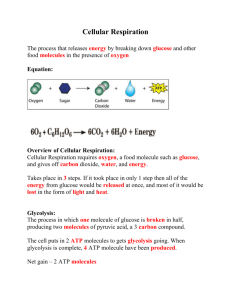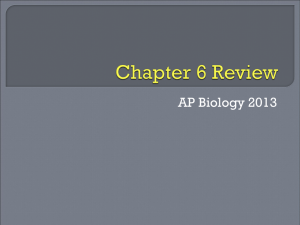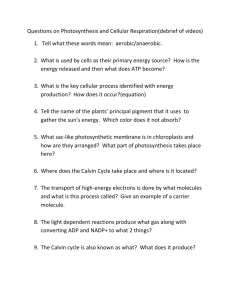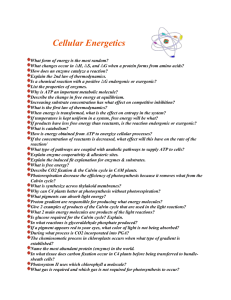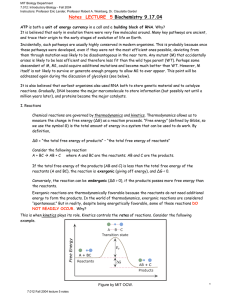YOU DO NOT NEED TO MEMORIZE THE STEPS OF GLYCOLYSIS
advertisement
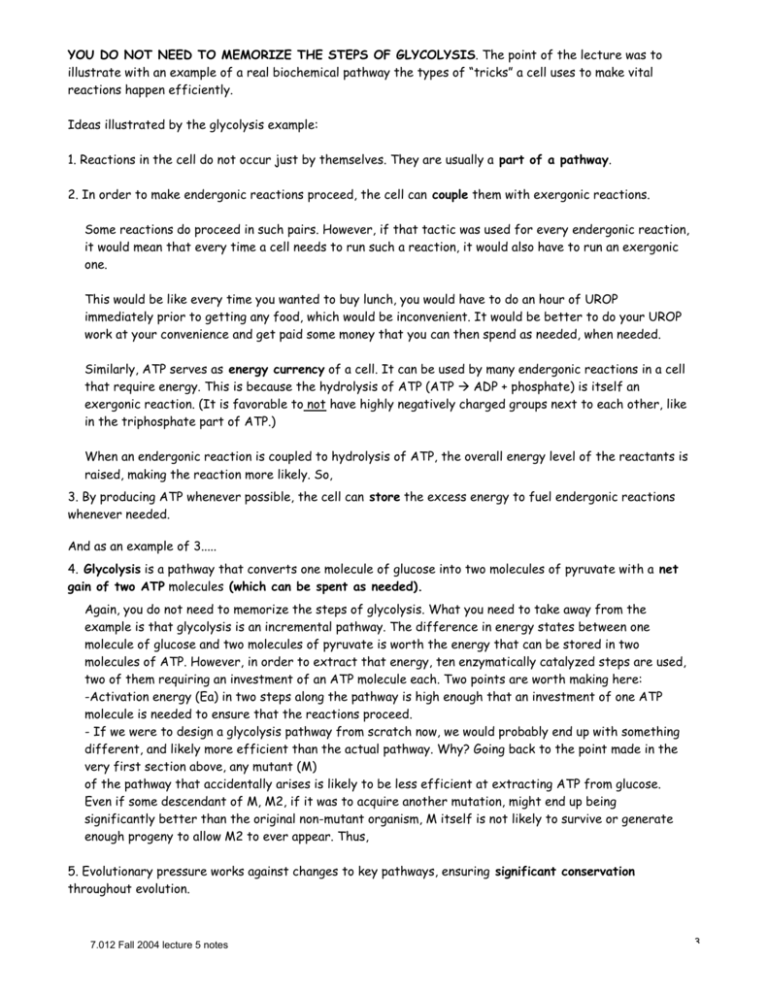
YOU DO NOT NEED TO MEMORIZE THE STEPS OF GLYCOLYSIS. The point of the lecture was to illustrate with an example of a real biochemical pathway the types of “tricks” a cell uses to make vital reactions happen efficiently. Ideas illustrated by the glycolysis example: 1. Reactions in the cell do not occur just by themselves. They are usually a part of a pathway. 2. In order to make endergonic reactions proceed, the cell can couple them with exergonic reactions. Some reactions do proceed in such pairs. However, if that tactic was used for every endergonic reaction, it would mean that every time a cell needs to run such a reaction, it would also have to run an exergonic one. This would be like every time you wanted to buy lunch, you would have to do an hour of UROP immediately prior to getting any food, which would be inconvenient. It would be better to do your UROP work at your convenience and get paid some money that you can then spend as needed, when needed. Similarly, ATP serves as energy currency of a cell. It can be used by many endergonic reactions in a cell that require energy. This is because the hydrolysis of ATP (ATP ADP + phosphate) is itself an exergonic reaction. (It is favorable to not have highly negatively charged groups next to each other, like in the triphosphate part of ATP.) When an endergonic reaction is coupled to hydrolysis of ATP, the overall energy level of the reactants is raised, making the reaction more likely. So, 3. By producing ATP whenever possible, the cell can store the excess energy to fuel endergonic reactions whenever needed. And as an example of 3..... 4. Glycolysis is a pathway that converts one molecule of glucose into two molecules of pyruvate with a net gain of two ATP molecules (which can be spent as needed). Again, you do not need to memorize the steps of glycolysis. What you need to take away from the example is that glycolysis is an incremental pathway. The difference in energy states between one molecule of glucose and two molecules of pyruvate is worth the energy that can be stored in two molecules of ATP. However, in order to extract that energy, ten enzymatically catalyzed steps are used, two of them requiring an investment of an ATP molecule each. Two points are worth making here: -Activation energy (Ea) in two steps along the pathway is high enough that an investment of one ATP molecule is needed to ensure that the reactions proceed. - If we were to design a glycolysis pathway from scratch now, we would probably end up with something different, and likely more efficient than the actual pathway. Why? Going back to the point made in the very first section above, any mutant (M) of the pathway that accidentally arises is likely to be less efficient at extracting ATP from glucose. Even if some descendant of M, M2, if it was to acquire another mutation, might end up being significantly better than the original non-mutant organism, M itself is not likely to survive or generate enough progeny to allow M2 to ever appear. Thus, 5. Evolutionary pressure works against changes to key pathways, ensuring significant conservation throughout evolution. 7.012 Fall 2004 lecture 5 notes 3 Notice that in anaerobic conditions, the net energy gain is only 2 ATP molecules from glycolysis. The produced NADH molecules are converted back to NAD+ as 2 pyruvate molecules get converted to 2 lactate molecules (in muscles) or 2 ethanol molecules (fermentation in yeast). These reactions occur in the cytoplasm. In aerobic conditions, pyruvates are further broken down in mitochondria to generate more NADHs and FADH2s through the Krebs’ (citric acid) cycle. These molecules are then used to pump protons that can subsequently be used to drive ATP synthase in the inner mitochondrial membrane. The net ATP production is 34 ATPs (from Kreb’s cycle and the electron transport chain) + 2 ATPs (from glycolysis) = 36 ATPs. Chart removed due to copyright reasons. Again, there is no need to memorize the technical details. The point here is 6. Before O2 appeared in the atmosphere, only two molecules of ATP were generated per molecule of glucose. Organisms utilizing this system couldn’t be very fast, or big, or smart. Recall that life on Earth first appeared more than 4 billion years ago, and eukaryotic cells appeared probably around 1.5 billion years ago, but O2 did not appear in significant amounts until about 600 million years ago. So it’s the appearance of oxygen that allowed for rapid evolution and diversity found on Earth. 7. Final point. There is a large number of biochemical pathways that interact. These interacting pathways allow the organism to take a sugar source and synthesize everything else needed. Again, many of these reactions are endergonic, so cells use ATP to facilitate them. 7.012 Fall 2004 lecture 5 notes 4




